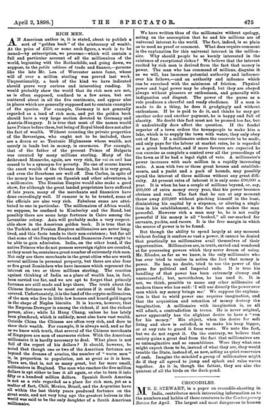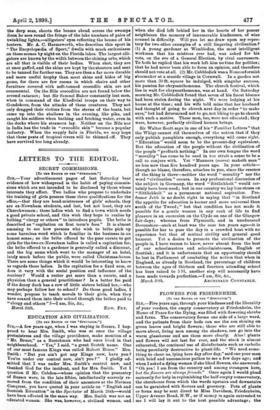CROCODILES.
MR. E. STEWART, in a paper on crocodile-shooting in India, contributes much interesting information as to the numbers and habits of these creatures to the Contemporary Review for April. The largest and most dangerous to human
life of the Indian species is the salt-water crocodile of the estuaries (C. porosus). This sometimes reaches 30 ft. in length, and cruises for its prey like a shark, occasionally swimming some distance out to sea. But the creature with which Mr. Stewart is mainly concerned is the marsh crocodile, the " mugger " of the inland rivers. Its numbers are very great and do not diminish. On one small river, the Tiljooga in Tirhoot, a stream not more than ten or twelve yards broad, but very deep, crocodiles might be seen every sixty yards, singly or in groups, which took toll of men, dogs, and cattle, as well as fish. What a curse they are to the inhabitants of the riverine districts may be gathered from the fact that the village watering places have to be palisaded to keep these creatures out, and that in spite of this a big "bull crocodile" will attach himself permanently to some such spot, just as a pike frequents a particular pool, and live on the toll he takes from the village. He is then known as a " burka luggaree goh," or "crocodile moored like a boat."
Such a beast is the subject of Hr. Rudyard Kipling's story "The Undertaker," in which the "mugger of Mugger Ghent" tells his own tale. His feasts of drowned carrion, his con- stancy to the ford and the bathing " ghaut," where he carries off men, women, and children yearly, and his adventures when he changes his quarters to distant haunts by using small tributaries, creeks, and irrigation cuts, are all strictly in keeping with the observations of Mr. Stewart and other Indian naturalists. The former adds some ghastly corrobora- tion to the details of this autobiography of a "mugger," though, incidentally, he mentions that this name is English, —not Indian. When out tiger-shooting he came across a huge crocodile sleeping on the bank of a small stream, —for crocodiles will travel up the smallest waterways at certain seasons, and populate any pools formerly free from them. The crocodile was shot, and his men at once ant it open to extract the gall-bladder, which is looked upon as a valuable charm. Inside this creature's stomach were two skulls and the putrid remains of as many bodies. He also witnessed a crocodile's attack on children at a bathing-ghaut. The creature was swimming on the surface holding a little native girl in its mouth, while the father was paddling in pursuit in a canoe, and striking the creature with a bamboo. It dropped its victim, but she was so frightfully injured that she died. Mr. Kipling notes that the " parish " mugger, which had taken toll of the inhabitants of the village since it was founded, was in time raised to the dignity of a " godling," or local fetish. This seems to show the process by which the crocodile-worship became gradually stereotyped in parts of ancient Egypt, the creature being propitiated because it was a peat. Herodotus is careful to mention that it was only in some villages that the creature was worshipped. His words are :—" Among some of the Egyptians the croco- dile is sacred, while others pursue him as an enemy. The inhabitants of Thebais and of the shores of Lake Mceris regard him with veneration. Each person has a tame croco- dile. He puts pendants of glass and gold in its ear-flaps, and gives it a regular allowance of food daily. When it dies it is embalmed But the inhabitants of Elephantine eat the crocodile, and do not think it sacred at all." Possibly these were the villages which suffered most from "parish croco- diles," while others which were not so cursed, or had a more enterprising population, cheerfully angled for them, and probably, as they do now, cooked and ate them. At Dongola they were formerly rather proud of their crocodile stews, and the flavour of the animal was considered to be superior there to that of "down-river crocodiles," just as some people praise an Arundel sole or an Amberley trout.
Herodotus, to whose method of setting down what be saw or heard, however incredible it might appear, time is always doing justice, has two excellent testimonials as to his croco- dile stories. One is Strabo, and the other Mr. Brehm. Strabo was taken by a priest to see a sacred crocodile kept in a pond at Arsinoe. "Our host," he writes, "who was a person of importance, and our guide to all sacred eights, went with us to the tank, taking with him from a table a small cake, some roast meat, and a small cup of mulled wine. We found the crocodile lying on the bank. The priests immediately went up to him, and while some of them opened his mouth, another put in the cake and crammed down the meat, and finished by pouring in the wine." We are not surprised to hear that after the last dose the crocrodile " jumped into the water and swam away." Brehm saw what Herodotus did not see, the manners and customs of the crocodiles on the White Nile at the time when the river-bed becomes the resort of the greater part of the bird population of that portion of the Soudan. This occurs at low Nile, when the water-supply elsewhere disappears, and the sandbanks are the nightly resting-place of millions of cranes, storks, ibises, pelicans, and geese. In the evening these sandbanks are white, grey, or crimson from the solid masses of birds, the most brilliant of which are the tantalus ibises. By night these feathered crowds are constantly " rushed " by the crocodiles, which during this season live more on fowls than on fish. The incredible number of the birds is maintained from two sources. Part are recruited by the migrants from Europe and Asia. Part are native birds which have reared their young earlier, and bring them to the river when the African steppe is too parched to yield food. Among these native birds is the " zie-zac," which Herodotus called the trochilus. Now, as then, it is the constant attendant of the crocodile, and spends its whole life on the sandbanks, which these monsters also haunt. Brehm not only watched it feeding round the crocodiles, and even prying into their open jaws, as these creatures commonly sleep with their mouth open and the lower jaw dropped, but also noted their extreme cunning in other respects. At the season of low Nile the crocodile bird is more constant to the sandbanks even than the crocodiles themselves. The latter only use them to bask on by day. The birds sleep there and lay their eggs on the sand. Brehm, though certain that they were nesting, never succeeded in finding the eggs. One day he saw a bird give two or three scratches with its feet before it flew off the bank. He swept away the sand and found that underneath it were the eggs. The crocodile bird, like the crocodile, buries its eggs, though it takes the trouble to hatch them itself. Crocodiles are now credited with one virtue,— the only one ever ascribed to them. Some species make a nest; and others are very jealous and bold in defending their eggs. The nest-making crocodile is the estuary species (C. porosus), "the man-eating crocodile par excellence of the East," according to Mr. H. P. Carter. It makes a mound of river vegetation, and leaves this to hatch the eggs when the mass ferments, on the plan adopted by the mound-making birds of Australia. Near this nest it keeps watch, much after the manner of a cock swan. It is on record that this is one of the very few nests which the native boy respects, without any deterrent local opinion. But the " mugger " is also a careful parent while its eggs are hatching. Mr. Stewart notes that the female " mugger " always watches by its eggs, and drives off not only human beings, but dogs and crows that approach the place where they are hidden in the sand. The discovery that "crocodile skin" makes the most beautiful natural leather in the world was due to accident. Sports- men who had killed specimens and wished to bring home the horn-plated hides as trophies, had the whole skin tanned. This included not only the plated portion, but the sides, neck, and belly of the creature. The handsome markings and " grain " of the skin, and fine tone taken by the leather, were remarked. Before long bags of crocodile hide were made in New York for visitors who had brought the leather from Florida. It then became fashionable for the most luxurious form of bag, dressing-ease, and leather trinkets; and though it is less durable than pigskin, being liable to split where the deeper markings cross, it remains the most popular material for this kind of article de luxe. Most of this leather is alligator skin, not crocodile, and the main. supply comes from the swamps and rivers of Florida. In this exquisite climate, and among the quays, streams, coral reefs, and lakes of the peninsula, the life of birds and fish seems almost at its maximum intensity. Bat wonderful as are the swarms of sea birds—pelicans, cormorants, and herons—the fish population is even more extraordinary, because not only the numbers but the size of the species is incredibly augmented by the vast supply of food. There the herring is represented by the gigantic tarpon, 5 ft. long; and sharks, monstrous balacondas, giant turtles, and other maritime monsters swarm in the warm rivers and salt lagoons. There the alligators, fed on this bountiful fare, swarm also ; and great as is the demand for their skins, alligator-shooting by night still yields a plentiful supply, and affords a novel, if rather tame, sport. Each shooter fastens a dark lantern to his cap, and, thus equipped, into in the bows of a canoe, and like some luciferous monster of
-the deep seas, shoots the beams ahead across the swamps Soon he sees round the fringe of the lake numbers of pairs of twinkling lights,—alligators' eyes reflecting the beams of his lantern. Mr. A. C. Harmsworth, who describes this sport in "The Encyclopedia, of Sport," dwells with much enthusiasm on these scenes by night on the Florida lakes. The largest alli- gators are known by the width between the shining orbs, which are all that is visible of their bodies. When shot, they are at once gaffed, and the skins are kept by the shooters and sent to be tanned for farther use. They are then a far more durable and more useful trophy than most skins and hides of big game, for there are few rooms in which chairs and other furniture covered with soft-tanned crocodile skin are not ornamental. On the Nile crocodiles are not found below the second cataract; but Sir Samuel Baker constantly lost men, when in command of the Khedivial troops on their way to Gondokoro, from the attacks of these creatures. They not only dragged their victims from the sterns of the boats, but came up into the shallows in the evening, like pike, and caught his soldiers when bathing and fetching water, even in the docks where his steamers lay. Neither on the Nile nor in India has the trade in "crocodile skin" become a popular industry. When the supply fails in Florida, we may hope that these pests of tropical rivers will be thinned off. They have survived too long already.




































 Previous page
Previous page